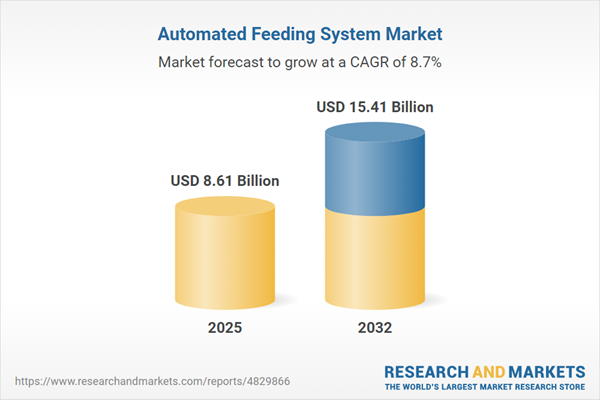Speak directly to the analyst to clarify any post sales queries you may have.
Automated feeding systems are transforming the landscape of commercial animal nutrition, delivering streamlined operations and enhanced governance for organizations seeking effective, technology-enabled resource management. Robust system adoption is driving tangible benefits in performance, compliance, and strategic planning for senior decision-makers in diverse production environments.
Market Snapshot: Automated Feeding System Market Size & Opportunity
The automated feeding system market reached a valuation of USD 7.93 billion in 2024, with forecasts indicating growth to USD 8.61 billion in 2025 and USD 15.41 billion by 2032. This positive trajectory demonstrates increased implementation of automated feeding systems in multi-site and complex production settings. Market expansion is underpinned by strategic priorities such as operational efficiency, regulatory responsiveness, and the integration of digital analytics. Real-time sensor technology and digital management platforms enable more precise feed delivery and support adherence to evolving welfare regulations. Senior leaders are positioned to drive competitive advancement through digital acceleration and data-driven oversight.
Scope & Segmentation: Automated Feeding System Market Breakdown
- Animal Types: Solutions apply to cattle, poultry, swine, aquaculture, and companion animal operations, each area benefitting from technology that reinforces productivity and supports species-specific nutrient protocols.
- Feeder Types: Belt, bowl, magnetic, screw, and vibratory feeders are all utilized according to facility scale, production methods, and environmental targets.
- Automation Levels: Systems span from semi-automatic to fully automated, enabling organizations at different digital maturity stages to participate.
- Control Technologies: Options include remote controls, photoelectric devices, proximity sensors, ultrasonic components, and time-driven modules, which facilitate improved feed management transparency and reliability.
- Distribution Channels: Products are accessed via authorized distributors, OEMs, and specialized e-commerce platforms, helping organizations address logistics challenges and compliance nuances in varied regions.
- Regional Coverage: Market presence encompasses the Americas, Europe, Middle East and Africa, and Asia-Pacific. Notably, countries such as China, India, the United States, and Brazil present distinct opportunities and implementation considerations for automated solutions.
- Key Companies: OMEGA GROUP, GEA Group Aktiengesellschaft, TAD Bowl Feeders, Universal Power Conversion, Inc., and RNA Automation Limited are advancing automation capability and readiness sector-wide.
Key Strategic Takeaways for Decision-Makers
- Implementing automated feeding systems establishes repeatable and reliable feeding cycles, reducing manual labor and bolstering quality standards across various production frameworks.
- Analytics powered by real-time sensors improve predictive maintenance, enabling organizations to plan resources effectively and minimize unexpected downtime.
- Modular architectures support seamless scaling or component updates, allowing organizations to adapt to growth or process changes with minimal financial disruption.
- Collaborating with manufacturers and technical partners ensures compliance with evolving local and regional regulations, promoting smooth transitions as policies change.
- Remote monitoring capabilities supply continuous operational visibility, empowering management to respond promptly to system fluctuations and optimize outcomes.
- Procurement strategies designed for a changing supply landscape help organizations mitigate compliance risks and maintain sourcing reliability.
Tariff Impact: Navigating Global Trade Volatility
The introduction of tariffs in the United States affecting essential inputs such as steel and electronics has impacted the sector’s cost structure. Leading organizations have adapted by nearshoring, expanding supplier bases, and redesigning key system components, which reduces vulnerability to geopolitical disruption and ensures ongoing access to critical equipment.
Methodology & Data Sources
Findings are based on the review of recent trade publications, regulatory filings, executive-level interviews, and comprehensive industry surveys. Input from subject-matter experts ensures that the analysis delivers actionable intelligence for shaping effective automated feeding system strategies and procurement choices.
Why This Report Matters: Strategic Value for Leadership Teams
- Guides leadership in aligning automation investments with broader business objectives, supporting consistency and compliance within animal nutrition programs.
- Equips procurement, operational, and partnership leaders with practical, region-specific recommendations to address regulatory variations and emerging market conditions.
- Enables executive teams to navigate the complexities of digital transformation and global sourcing with clear, actionable insights relevant to evolving technology and compliance landscapes.
Conclusion
Automated feeding systems are driving improvements in operational continuity and readiness for regulatory change. Their integration enables organizations to address persistent challenges in animal nutrition management with confidence and agility.
Additional Product Information:
- Purchase of this report includes 1 year online access with quarterly updates.
- This report can be updated on request. Please contact our Customer Experience team using the Ask a Question widget on our website.
Table of Contents
3. Executive Summary
4. Market Overview
7. Cumulative Impact of Artificial Intelligence 2025
Companies Mentioned
The companies profiled in this Automated Feeding System market report include:- OMEGA GROUP
- TAD Bowl Feeders
- QUALITY SYSTEMS & EQUIPMENTS PVT. LTD.
- Technosmart Automation Pvt. Ltd.
- GEA Group Aktiengesellschaft
- Universal Power Conversion, Inc.
- Schauer Agrotronic GmbH
- Naganpuriya Group
- M&S Automated Feeding Systems, Inc.
- RNA Automation Limited
Table Information
| Report Attribute | Details |
|---|---|
| No. of Pages | 183 |
| Published | October 2025 |
| Forecast Period | 2025 - 2032 |
| Estimated Market Value ( USD | $ 8.61 Billion |
| Forecasted Market Value ( USD | $ 15.41 Billion |
| Compound Annual Growth Rate | 8.6% |
| Regions Covered | Global |
| No. of Companies Mentioned | 11 |









